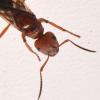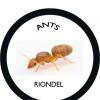- Formiculture.com
- Forums
- Gallery
- Members
- Member Map
- Chat

Red Queen from Merritt, British Columbia, Canada (2017-09-25)
Started By
proto
, Sep 26 2017 2:20 AM
ant queen queen ant id request

Best Answer VoidElecent , September 26 2017 - 1:07 PM
Queen #66 looks like Manica, and Queen #73 is Myrmica.
Thanks for the info on the Genus. Would you happen to know what species they are or how I can help you determine the sp? (better close-ups of certain parts)
If it's Manica, it would either be M. hunteri or M. invidia; you'd have to refer to someone else for a more accurate identification.
Myrmica, on the other hand, are notoriously difficult to ID and you'd need some pretty intense magnification.
Go to the full post
7 replies to this topic
#1
 Offline
-
Posted September 26 2017 - 2:20 AM
Offline
-
Posted September 26 2017 - 2:20 AM
I was wandering around a gravel area and beyond this area is fields of long tall yellow wheat grass.
SPECIES 1 QUEEN ANT #66
1. Location of Collection: Merritt, British Columbia (Coordinates: 50.087869, -120.746469)
2. Date of Collection: 2017-09-25
3. Habitat of Collection: gravel patch outside a visitor center (https://goo.gl/maps/Yw3CVXNuVtG2).
4. Length: 9mm
5. Coloration: mostly brown/reddish color.
6. Distinguishing characteristics: 12 antennae segments, petiole and post-petiole nodes present, lots of fine hairs on thorax
7. Distinguishing behavior:
SPECIES 2 QUEEN ANT #73
1. Location of Collection: Merritt, British Columbia (Coordinates: 50.087869, -120.746469)
2. Date of Collection: 2017-09-25
3. Habitat of Collection: gravel patch outside a visitor center (https://goo.gl/maps/Yw3CVXNuVtG2).
4. Length: 7-8mm
5. Coloration: black with light brown extremities.
6. Distinguishing characteristics: 12 antennae segments, petiole and post-petiole nodes present, two points at the end of the thorax, lots of fine hairs
7. Distinguishing behavior:
I'm new to this as of May 2017 and I'd have to say that this site is such an amazing resource. Having pros helping to ID ants is incredible and super helpful. I will be applying to GAN Project for Vancouver (lower mainland) once I have some worker colonies as per Ants Canada.
- Formica podzolica (12)
- Lasius alienus (33)
- Myrmica sp. (3)
#2
 Offline
-
Posted September 26 2017 - 7:21 AM
Offline
-
Posted September 26 2017 - 7:21 AM
Queen #66 looks like Manica, and Queen #73 is Myrmica.
#3
 Offline
-
Posted September 26 2017 - 10:21 AM
Offline
-
Posted September 26 2017 - 10:21 AM
The second queen looks more like Myrmecina to me.
#4
 Offline
-
Posted September 26 2017 - 11:33 AM
Offline
-
Posted September 26 2017 - 11:33 AM
The second queen looks more like Myrmecina to me.
Myrmecina would be around 3 or 4 millimeters.
#5
 Offline
-
Posted September 26 2017 - 1:04 PM
Offline
-
Posted September 26 2017 - 1:04 PM
Queen #66 looks like Manica, and Queen #73 is Myrmica.
Thanks for the info on the Genus. Would you happen to know what species they are or how I can help you determine the sp? (better close-ups of certain parts)
I'm new to this as of May 2017 and I'd have to say that this site is such an amazing resource. Having pros helping to ID ants is incredible and super helpful. I will be applying to GAN Project for Vancouver (lower mainland) once I have some worker colonies as per Ants Canada.
- Formica podzolica (12)
- Lasius alienus (33)
- Myrmica sp. (3)
#6
 Offline
-
Posted September 26 2017 - 1:07 PM
Best Answer
Offline
-
Posted September 26 2017 - 1:07 PM
Best Answer
Queen #66 looks like Manica, and Queen #73 is Myrmica.
Thanks for the info on the Genus. Would you happen to know what species they are or how I can help you determine the sp? (better close-ups of certain parts)
If it's Manica, it would either be M. hunteri or M. invidia; you'd have to refer to someone else for a more accurate identification.
Myrmica, on the other hand, are notoriously difficult to ID and you'd need some pretty intense magnification.
- proto likes this
#7
 Offline
-
Posted September 26 2017 - 10:34 PM
Offline
-
Posted September 26 2017 - 10:34 PM
Like stated above the first one is definitely Manica, and the second one Myrmica.
Only way to tell if it is M. invidia or M. hunteri is by looking at the petiole node, in M. hunteri there is a spike like thing that juts out pointing towards the main body underneath it. The pictures are great but conveniently omit a side view of the petiole ![]()
For the Myrmica the size would lead me to believe it is M. incompleta, but I'm not sure if their range extends that far north or inland. Myrmica crassirugis and easily mistakened M. lobifrons and M. latifrons are what I would wager with. Other possibilities are Myrmica alaskensis and Myrmica nearctica, both which I believe are pretty small (Workers ~3.5mm). I don't know the exact size of any of the castes in the above mentioned Myrmica besides M. incompleta (Queens range from 5.5-7mm). If you can get a good shot of the face that might help.
Edited by LC3, September 26 2017 - 11:12 PM.
#8
 Offline
-
Posted September 27 2017 - 8:35 AM
Offline
-
Posted September 27 2017 - 8:35 AM
We need to use specific morphological features other than size to identify Myrmica. You generally need a microscope to do it properly.
- VoidElecent likes this
If you've enjoyed using my expertise and identifications, please do not create undue ecological risk by releasing your ants. The environment which we keep our pet insects is alien and oftentimes unsanitary, so ensure that wild populations stay safe by giving your ants the best care you can manage for the rest of their lives, as we must do with any other pet.
Exotic ants are for those who think that vibrant diversity is something you need to pay money to see. It is illegal to transport live ants across state lines.
----
Black lives still matter.
Also tagged with one or more of these keywords: ant queen, queen ant, id request
Ant Keeping →
Ant Keeping Journals →
Futurebird's Park Ave. Winter Ant QueenStarted by futurebird , Apr 10 2024 |
|

|
||
Ant Keeping →
General Ant Keeping →
New Queen AntStarted by cooIboyJ , Mar 20 2024 |
|

|
||
 |
Market Place →
General Market Place →
UtahAnt's Flash Sale Thread - Selling queens and colonies in UtahStarted by UtahAnts , Aug 2 2023 |
|

|
|
Market Place →
General Market Place →
Looking to buy queen, in FloridaStarted by Missingno , May 12 2023 |
|

|
||
Ant Keeping →
General Ant Keeping →
Honeypot Queen Placement? Please helpStarted by JonnyTorch , Jan 8 2023 |
|

|
1 user(s) are reading this topic
0 members, 1 guests, 0 anonymous users

















